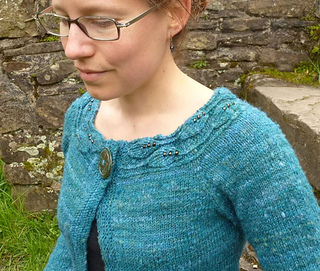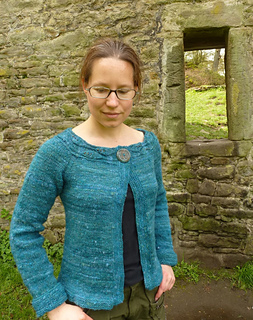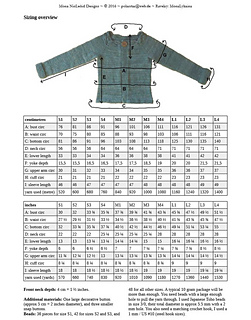patterns >  knitting in spaceships
knitting in spaceships
> Cascadian














Cascadian
Deutsche Info siehe unten.
A batch of handdyed handspun yarn was the initial inspiration for this “wood elf” cardigan. The leaf yoke is a great opportunity to try knitting with beads. The simple shape of the body is perfect for showcasing a tweedy or heathered yarn, and the pattern includes nifty adjustable shaping with bust and waist darts and underarm gussets.
Sizing / yarn requirements: See bottom picture for detailed sizing and yardage table and information about beads.
The garment is intended to be worn with 2-3 cm = about an inch of positive ease around the bust and a looser fit around the bottom edge.
The 12 sizes are grouped into three sets with slightly different proportions, and the pattern contains detailed modification advice.
The cardigan is shown in size S3 on a person with a 84 cm / 33’’ bust and a 90 cm / 35’’ hip
Yarn advice:
The original cardigan was knitted with a handspun wool of approximately 200 m per 100g. The design lends itself to a wide variety of rustic or more refined wool yarns in the heavy dk to light aran range. Two strands of fingering yarn held together will often result in a similar thickness, which expands the possibilities even more.
Needle advice:
Use the needle size that gives you the required gauge, most likely 3 – 3.5mm / US 2 ½ – 4. You will need a medium long circular needle (80 - 100 cm / 32 - 40’’) to knit the yoke and the body. The sleeves can be worked with “magic loop” or with dpns.
Construction:
The garment is worked top down, starting with the leaf band which is worked sideways with short row shaping. Then stitches are picked up along the longer edge of the band, and the lower part of the yoke is worked with raglan increases. Then the sleeve stitches are put on hold, while the front and back of the body are joined and worked towards the bottom edge with waist shaping. Next the sleeves are also worked top down in the round. Finally stitches are picked up along the front edges for the buttonbands.
The stitch pattern for the leaf band is given as a chart only.
~~~
Ein handgefärbtes, handgesponnenes Garn war die ursprüngliche Inspiration für diese “Waldelfen”-Jacke. Die Blätterborte ist eine tolle Gelegenheit, einmal das Einstricken von Perlen auszuprobieren. Der schlichte Schnitt eignet sich perfekt für ein lebendiges Tweedgarn oder eine melierte Wolle, und die Anleitung bietet eine Menge Möglichkeiten zur individuellen Anpassung durch Taillierung mit Abnähern und Achselzwickel.
Größen und Garnverbrauch: siehe detaillierte Tabelle im untersten Bild.
Die Jacke sollte mit einer Mehrweite von 2 bis 3 cm im Brustbereich und etwas weiterem Sitz an der Unterkante getragen werden.
Die 12 Größen sind in drei Gruppen unterteilt, die sich in ihren Proportionen unterscheiden. Die Anleitung enthält detaillierte Anpassungshinweise.
Die Jacke wird auf den Photos in Größe S3 von einer Person mit 84 cm Brustumfang und 90 cm Hüftumfang getragen.
Garn:
Die Originaljacke wurde mit handgesponnener Wolle mit einer Lauflänge von ca. 200 m / 100g gestrickt. Zu diesem Modell passt eine große Bandbreite an rustikalen oder eleganteren Woll- oder Wollmischgarnen. Zwei Fäden in Sockenwollstärke ergeben oft eine ähnliche Stärke, dadurch erweitern sich die Möglichkeiten noch mehr.
Nadeln:
Verwende die Nadelstärke, mit der du die angegebene Maschenprobe erreichst, wahrscheinlich 3 - 3,5 mm. Es wird eine mittellange Rundstricknadel (80-100 cm) benötigt, um den Körper zu stricken. Die Ärmel können mit “magic loop” oder mit einem Nadelspiel gestrickt werden.
Konstruktion:
Die Jacke wird von oben nach unten gestrickt, angefangen mit der Blätterborte, die quer gestrickt und mit verkürzten Reihen geformt wird. Danach werden Maschen an der Unterkante der Blätterborte aufgenommen und der Rest der Passe mit Raglanzunahmen gestrickt. Dann werden die Ärmelmaschen stillgelegt und das Vorder- und
Rückenteil des Körpers verbunden, um den Körper bis zur Unterkante zu stricken, wobei eine Taillierung eingearbeitet wird. Als nächstes werden die Ärmel in der Runde bis zum Bündchen gestrickt, wobei Zwickel an den Achseln für eine bequeme Passform sorgen. Zum Schluss werden entlang der Vorderkanten Maschen für die Knopfleisten aufgenommen.
- First published: April 2016
- Page created: April 16, 2016
- Last updated: February 2, 2023 …
- visits in the last 24 hours
- visitors right now





